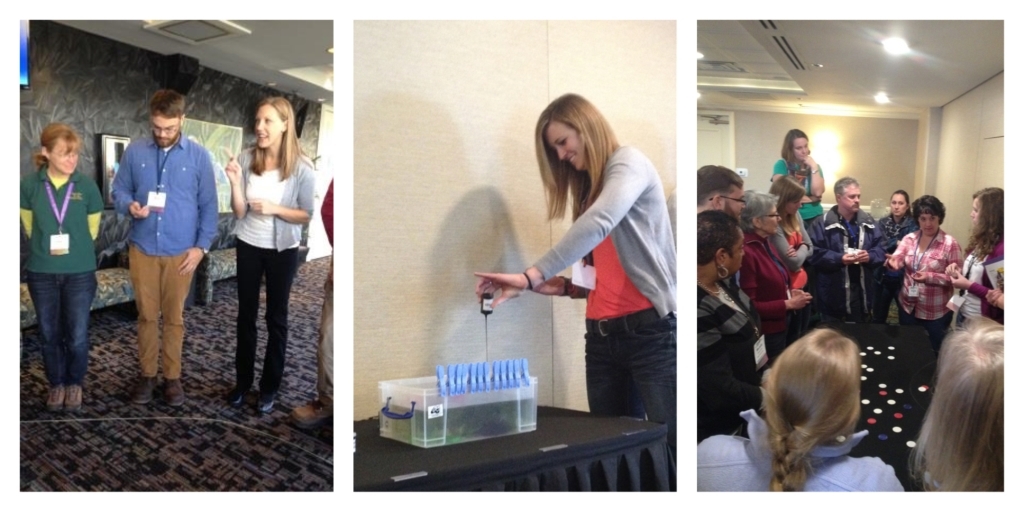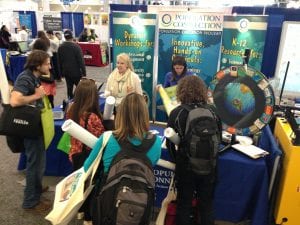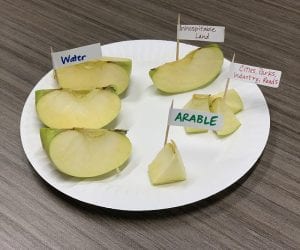Last Friday I had the pleasure of presenting a workshop at the Maryland Association for Environmental and Outdoor Education’s (MAEOE) annual conference. The three-hour pre-conference workshop proved to be well-worth the trip out to blustery Ocean City on the eastern shore of Maryland.
Nineteen enthusiastic educators joined me for the session, coming in not just from Maryland, but Delaware, DC and Virginia as well. And the audience was quite diverse – we had a Spanish teacher, an elementary school principal, a park ranger, and a whole variety of classroom teachers and non-formal educators. Their different backgrounds and experiences with teaching about sustainability were an asset to the workshop, allowing for in-depth discussion from many viewpoints.

As we do with all Population Ed workshops, we spent the majority of the session going through classroom lessons and activities – not just talking about them, doing them. After watching the World Population “dot” video, taking part in the lesson Population Circle, and examining the human population growth j-curve graph, the participants had a strong sense of how our numbers have changed exponentially over time. It was at that point a participant asked – “But do your lessons get into how our increasing numbers impact the planet’s resources?” You’d have thought I paid him ahead of time to provide me with such an easy transition to the next lessons – those looking at carrying capacity, resource consumption and human impacts on the earth!
Each resource-related lesson we covered sparked interesting discussion but I’ll just point out two. The first was Code Blue: Endangered Oceans, a lesson that looks at how increasing population has impacted the oceans over time. With representatives of the James River Association, the Poplar Island Environmental Service, states parks, and a Master Naturalist there were many connections made to local water issues that have global impacts – from Richmond’s impermeable ground and resulting spring sewage floods to how oyster populations in the Chesapeake Bay are managed.
The cooperative group activity One for All really livened the crowd towards the end of the workshop. Participants were challenged to work together to find a strategy for harvesting renewable resources in a sustainable way. Without too much difficulty, they agreed on a method for removing some of the resource without impacting its future availability. But after just a few rounds it was observed that students may not follow the group’s determined “rules” and an individual may clear the resource for their own personal gain. We tied this back to our discussion on the oceans – some countries agree to a strategy but then don’t comply themselves. Or groups hold others to rules that they themselves do not follow.
Participants agreed that population must be a part of environmental discussions and decisions as we educate students in “Looking Towards the Future” – the 2015 conference theme. With our global population expected to surpass 9 billion by mid-century, the well-being of the oceans and all the earth’s treasures will depend on our planning, innovation, and sustainable mindsets.
Standards covered during the Population Education session
Maryland Middle Schools Science standards
- Environmental Science: Explain interactions of environmental factors and analyze their impact from a local to a global perspective. (Natural Resources and Human Needs; Environmental Issues)
- Life Science: Explain the dynamic nature of living things, their interactions, and the results from the interactions that occur over time. (Evolution; Ecology; Diversity of Life)
Maryland High School Science standards
- Concepts of Biology: Explain the uniqueness and interdependence of living organisms, their interactions with the environment, and the continuation of life on earth.
- Environmental Science: Understand interrelationships of the natural world and to analyze environmental issues and their solutions.
Maryland Social Studies standards
- Geography: Examine the role of culture, technology, and the environment in the location and distribution of human activities and spatial connections throughout time. (Use geographic tools; Geographic characteristics of places/regions; Movement of people, goods and ideas; Modifying and adapting to the environment)
- Peoples of the Nation and World: Understand the diversity and commonality, human interdependence, and global cooperation of the people of MD, the US and the world through a multicultural and historic perspective. (Examine how increasing diversity in global societies results from immigration, settlement, and economic development)
- Economics: Understand the historical development and current status of economic principles, institutions, and processes needed to be effective citizens, consumers, and workers participating in local communities, the nation, and the world. (Scarcity and decision-making)




